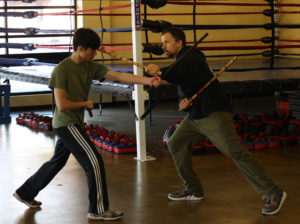 The importance of Footwork in Eskrima Training is a point that is generally under-appreciated by students of these arts. All too often you will see people playing advanced striking combinations from flat-footed, static positions. Without the necessary mobility provided by proper footwork people end up compromising their structure to avoid strikes when they attempt sparring or combat. Once you’ve compromised the structure, which is the foundation of every action you take, you have put yourself into what some describe as a “ready to be beaten” posture. Desperate evasions may save you from one attack but they leave you with little or no resources to deal with the attack that is likely following it.
The importance of Footwork in Eskrima Training is a point that is generally under-appreciated by students of these arts. All too often you will see people playing advanced striking combinations from flat-footed, static positions. Without the necessary mobility provided by proper footwork people end up compromising their structure to avoid strikes when they attempt sparring or combat. Once you’ve compromised the structure, which is the foundation of every action you take, you have put yourself into what some describe as a “ready to be beaten” posture. Desperate evasions may save you from one attack but they leave you with little or no resources to deal with the attack that is likely following it.
Within the first (Baguhan) rank of Lameco Eskrima there are some eighteen different variations of footwork that the student is required to learn. “Retirada Caballero,” is a familiar shuffle step, essentially the same as the basic first footwork that most boxers learn. This is a good technique for cautiously advancing and retreating without overly committing to the direction of movement. “Tusulok ilag yuko,” is a combination triangular dodge and duck. One evades the opponent’s line of attack and changes level to avoid any follow-ups. “Hakbang Pa’iwas” is a step to the side, avoiding the line of attack and reorienting to an advantageous position. Ideally preformed the one finishes the movement facing the side of their attacker, which has obvious advantages. These are just a few samples of the many techniques even a beginner in Eskrima should know. Learning these footwork patterns well enough to perform in a test is only the very beginning of the training. In order to be truly useful they must be trained to the point of precise instinct.
Footwork in Eskrima Training
The reason this footwork training is so vital is structure. A good posture is essential to effectively deliver and absorb force. It should provide stability in every direction. The body should be relaxed and able to move in any direction and one should be able to strike from any angle. The purpose of footwork is maintaining this useful structure while moving into attack position or moving to evade. The combination of good structure and footwork allows a person to strike at the exact moment of opportunity. Without these essentials of form and mobility, the vast majority of the moments of opportunity where you can succeed in a struggle will pass you by. In a fight between a person who knows ten techniques who trains properly and an individual who knows fifty techniques but doesn’t prioritize form and mobility practice, the fluidly mobile person is always much more likely to win.
In order to be skilled martial artists we must train our footwork constantly and extensively. Learn a broad variety of patterns. Train them until they are precise and instinctual. These movements and postures should feel like home, where you are totally at ease and comfortable practicing them in any situation. From here one can progress to combining the patterns into a variety of random flows. Then move to working them in unfavorable situations; obstacles, not enough space, uneven or unstable surfaces, etc. Footwork should be drilled as a regular part of your training. It is also something you can incorporate into the rest of your day. Any time you have a few idle minutes, practice. Training this consistently and at every opportunity will put you a step ahead of the pack when it comes to applying and relying on your Eskrima.

